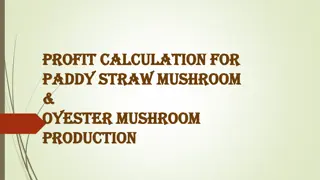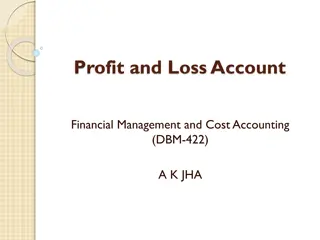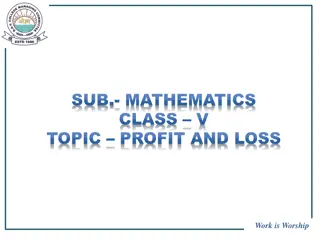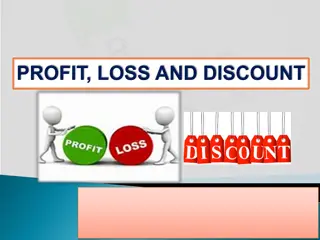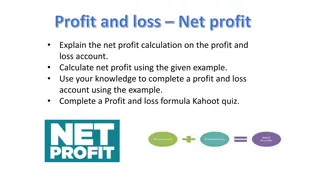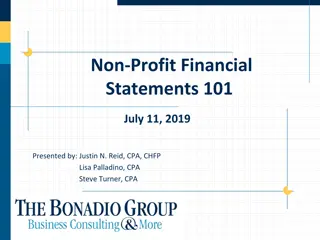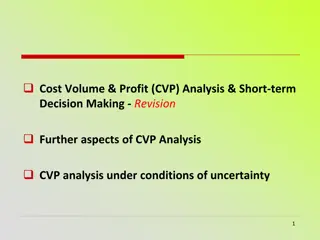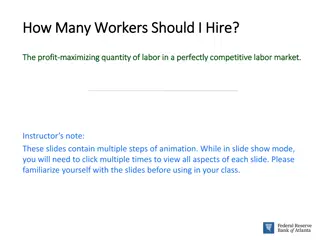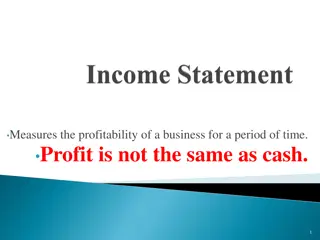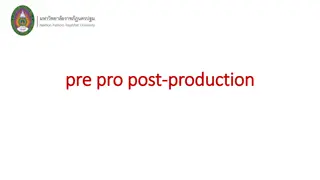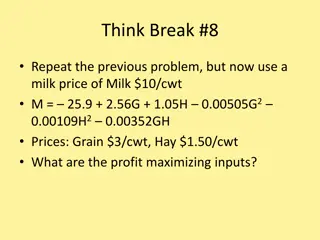Maximizing Profit in a Corn Production Scenario
In a perfectly competitive labor market producing corn, we aim to determine the optimal number of farmworkers to hire for profit maximization. By comparing the Marginal Revenue Product and Marginal Factor Cost, we analyze the additional corn production with each added worker. Through step-by-step calculations, we assess whether to hire more workers to boost profits.
Download Presentation

Please find below an Image/Link to download the presentation.
The content on the website is provided AS IS for your information and personal use only. It may not be sold, licensed, or shared on other websites without obtaining consent from the author. Download presentation by click this link. If you encounter any issues during the download, it is possible that the publisher has removed the file from their server.
E N D
Presentation Transcript
How Many Workers Should I Hire? Here s how to hire the profit-maximizing quantity of labor in a perfectly competitive labor market.
What are we producing? CORN! (Lots and lots of corn! Consumers like corn!)
How are we producing CORN? Field 1 Field 2 Seed Drill 1 Seed Drill 2 CORN CORN CORN CORN CORN CORN CORN CORN Team 1 Farmworkers Team 2 Farmworkers LOAN LOAN Work Period = 30 seconds
What do we want to know? EQ: How many farmworkers should we hire to maximize profits? The number of workers up to the point where MRP=MFC! Wage = $5 per farmworker Price = $8 per bushel of corn The additional amount of CORN produced by each per Bushel X Number of Bushels of CORN. farmworkers. Price per Bushel X MPP. Marginal Factor Cost = Wage per Worker X number of additional farmworkers hired each round. Total Revenue Product = Price Total Factor Cost = Wage per Worker X Number of Marginal Revenue Product = The number of times CORN is written in 30 seconds. additional farmworker.
What do we need? Ready? Let s go! Team Two Worker Recorder Mathematician Team One Worker Recorder Mathematician
Time for Math! Sample Calculation Price = $8 per bushel of corn Wage = $5 per farmworker $5 $80 $5 $80 10 10 Time for round 2! Each team picks an additional farmworker.
Time for Math! Sample Calculation Price = $8 per bushel of corn Wage = $5 per farmworker $5 $80 $112 $5 $10 $80 $32 10 14 10 4 $5 Time for round 3! Each team picks an additional farmworker.
Time for Math! Sample Calculation Price = $8 per bushel of corn Wage = $5 per farmworker $5 $80 $112 $5 $10 $15 $80 $32 10 14 10 4 $5 $8 1 $120 15 $5 Time for round 4! Each team picks an additional farmworker.
Time for Math! Sample Calculation Price = $8 per bushel of corn Wage = $5 per farmworker $5 $5 $80 $5 $10 $80 $80 $112 $112 $5 $10 $15 $80 $32 $32 10 10 10 14 14 10 4 4 $5 $5 > $8 1 $120 15 $5 < $20 0 $120 $0 $5 15 Do we need to run round 5?
Determining Returns to Scale Round 1 Round 2 Field 1 Field 2 Seed Drill 1 Seed Drill 2 CORN CORN CORN CORN CORN CORN CORN CORN Team 1 Farmworkers Team 2 Farmworkers LOAN LOAN Labor and capital increased by 100% in round 2. Did output Work Period = 30 seconds increase by 100%, more than 100%, or less than 100%?
Returns to Scale Essential Question Two: Are the returns to scale for a firm increasing, decreasing, or constant when doubling the quantity of labor and capital used in production? Wage = $5 per farmworker Rent per seed drill = $10 15 34 It is increasing; output more than doubles when labor and capital are doubled and average total cost falls from $1.00 per bushel to $0.88. ATC = (Wage X # of workers) + (Rent X # of drills) # of units of output
National Standards in Economics Students will understand that: - Effective decision making requires comparing the additional costs of alternatives with the additional benefits. Many choices involve doing a little more or a little less of something. Few choices are all or nothing decisions. Benchmarks: Grade 8 At the completion of Grade 8, students will know the Grade 4 benchmarks for this standard and also that: - to determine the best level of consumption of a product, people must compare the additional benefits with the additional costs of consuming a little more or a little less. - marginal benefit is the change in total benefit resulting from an action. Marginal cost is the change in total cost resulting from an action. - as long as the marginal benefit of an activity exceeds the marginal cost, people are better off doing more of it; if the marginal cost exceeds the marginal benefit, they are better off doing less of it. Benchmarks: Grade 12 At the completion of Grade 12, students will know the Grade 4 and Grade 8 benchmarks for this standard and also that: - to produce the profit-maximizing level of output and hire the optimal number of workers and other resources, producers must compare the marginal benefits and marginal costs of producing a little more with the marginal benefits and marginal costs of producing a little less.





